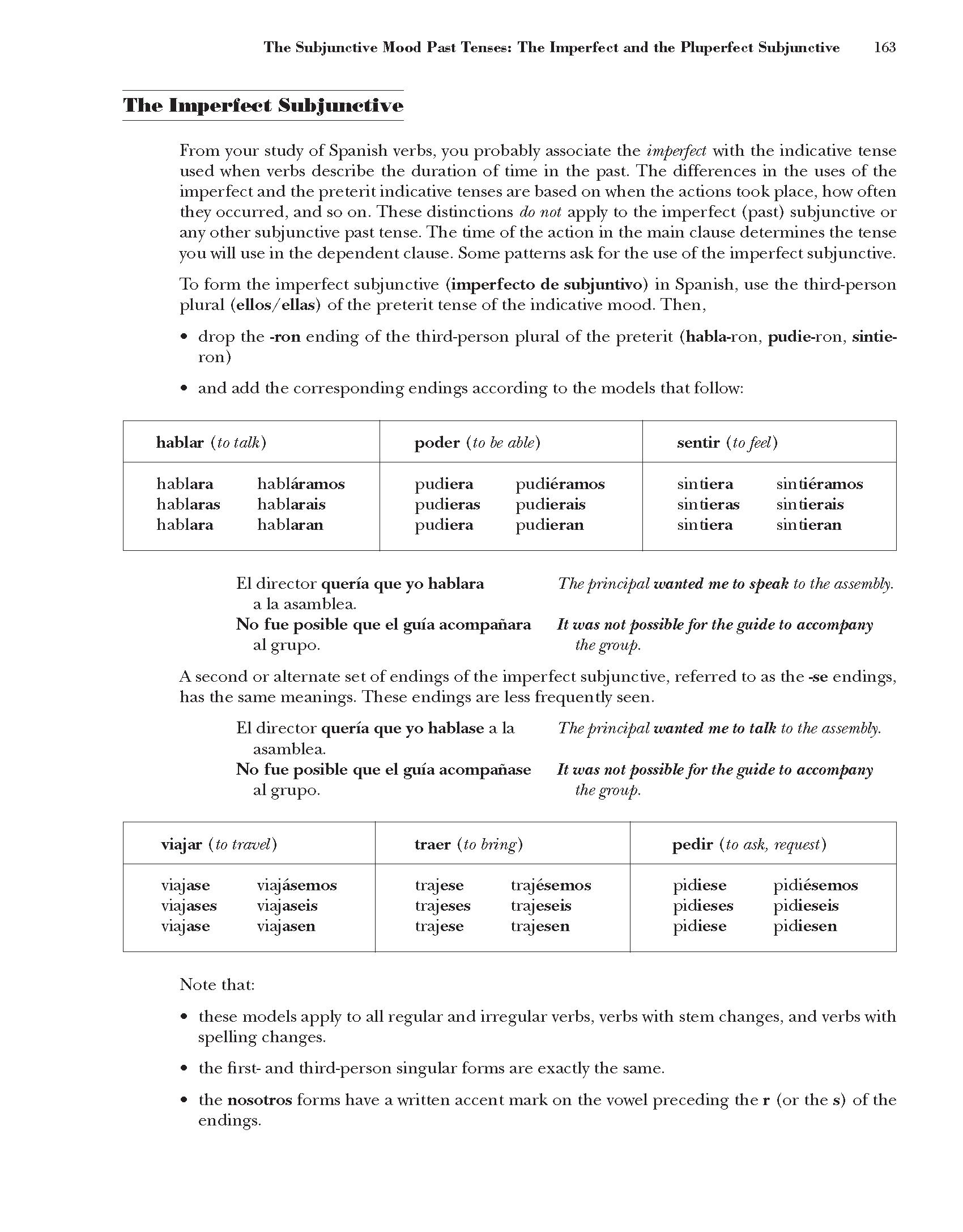CSG174

163
The Subjunctive Mood Past Tenses: The Imperfect and the Pluperfect Subjunctive
The Imperfect Subjimctive
From your study of Spanish verbs, you probably associate the imperfect with the indicative tense used when verbs describe the duration of time in the past. The differences in the uses of the imperfect and the preterit indicative tenses are based on when the actions took place, how often they occurred, and so on. These distinctions do not apply to the imperfect (past) subjunctive or any other subjunctive past tense. The time of the action in the main clause determines the tense you will use in the dependent clause. Some patterns ask for the use of the imperfect subjunctive.
To form the imperfect subjunctive (imperfecto de subjuntivo) in Spanish, use the third-person plural (ellos/ellas) of the preterit tense of the indicative mood. Then,
• drop the -ron ending of the third-person plural of the preterit (habla-ron, pudie-ron, sintie-ron)
• and add the corresponding endings according to the models that follow:
|
hablar (to talk) |
poder (to be able) |
sentir (tofeel) | |||
|
hablara |
hablar amos |
pudiera |
pudieramos |
sin dera |
sintieramos |
|
hablaras |
hablar ais |
pudieras |
pudierais |
sintieras |
sintierais |
|
hablara |
hablar an |
pudiera |
pudieran |
sin dera |
sintieran |
El director queria que yo hablara Theprincipal wanted me to speak to the assembly.
a la asamblea.
No fue posible que el guia acompanara It was not possible for the guide to accompany
al grupo. thegroup.
A second or alternate set of endings of the imperfect subjunctive, referred to as the -se endings, has the same meanings. These endings are less frequently seen.
El director queria que yo habla.se a la Theprincipal wanted me to talk to the assembly. asamblea.
No fue posible que el guia acompanase It was not possible for the guide to accompany
al grupo. thegroup.
|
viajar (to trcwel) |
traer (to bńng) |
pedir (to ask, reąuest) |
|
Yiajase viajasemos Yiajases viajaseis viajase viajasen |
trajese trajesemos trajeses trajeseis trajese trajesen |
pidiese pidiesemos pidieses pidieseis pidiese pidiesen |
Notę that:
• these models apply to all regular and irregular verbs, verbs with stem changes, and verbs with spelling changes.
• the first- and third-person singular forms are exactly the same.
• the nosotros forms have a written accent mark on the vowel preceding the r (or the s) of the endings.
Wyszukiwarka
Podobne podstrony:
CSG182 171 The Subjunctive Mood Past Tenses: The Imperfect and the Pluperfect Subjunctive •
CSG184 173 The Subjunctive Mood Past Tenses: The Imperfect and the Pluperfect Subjunctive In real an
CSG176 The Subjunctive Mood Past Tenses: The Imperfect and the Pluperfect Subjunctive 165 5. &
CSG178 167 The Subjunctive Mood Past Tenses: The Imperfect and the Pluperfect SubjunctiveOther Uses
CSG180 The Subjunctive Mood Past Tenses: The Imperfect and the Pluperfect
CSG182 171 The Subjunctive Mood Past Tenses: The Imperfect and the Pluperfect Subjunctive •
CSG184 173 The Subjunctive Mood Past Tenses: The Imperfect and the Pluperfect Subjunctive In real an
CSG173 Unit 15The 8ubjunotive Mood Past Tenses:The Imperfect and the Pluperfect Snbjnnctive Before l
CSG046 Unit 4The Preterit TenseRegular Verbs in the Preterit The preterit (el preterito) is one of s
File0014 I can tell a short stery osiny past ttnses. 2 1 $1.16 Read and liste
057 8 Nom©________ SkiU: Cut and past© 8« Cut out and pastę the triangles onto the matching
Conseryation ethic: it is good, a social duty, to preserve the past (Lipę 1977; Lowenthal and
ape 056 56 ANDERSONA PHYSICAL EDUCATION Figurk 24 Side to the E.erciser. Right arm down past front&n
więcej podobnych podstron